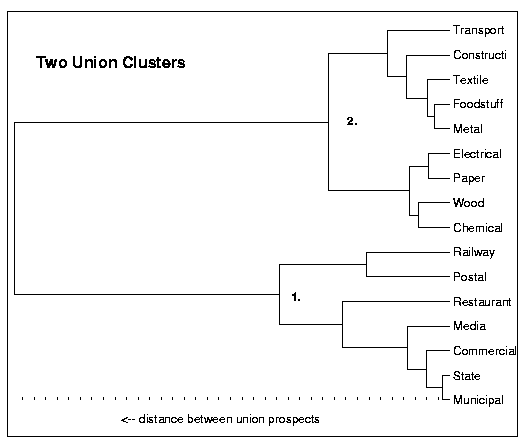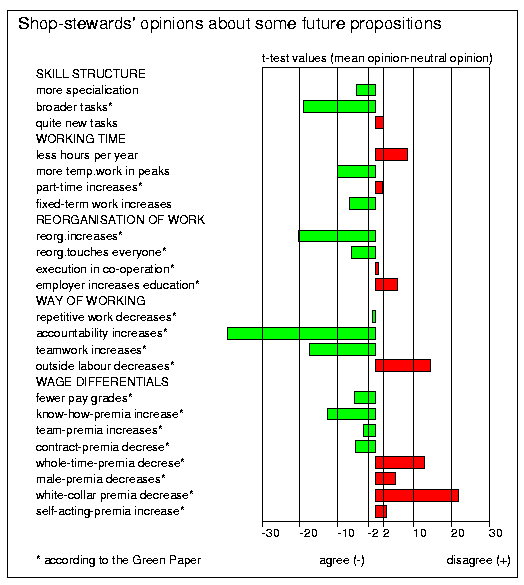* According to the
Green Paper
Differences Between Branches
With the help of grouping
analysis, unions can be defined in relation to each other. The unions holding similar
future expectations are close to each other and thus belong to the same cluster. The data
below includes the positions of shopstewards towards future statements by union and branch
of economy.
- The union-specific positions constitute two union clusters. The core of the 'service
cluster' is formed by the union pair municipality-state around which other service
clusters are grouped. The Railway Men's Union and the Postal Workers' Union are furthest
away from the core. Correspondingly, the core of the 'industrial cluster' is the
union pair foodstuff-metal. The Transport Workers' Union and the Construction Trade Union
are furthest away from the core. The major differences between clusters seem to apply to
the relationship between accountability and wage supplements. In the service cluster, this
relationship is more obscure.

The branch-specific positions constitute five branch clusters. The distance between
branches is greater than it is between unions if estimated by the number of clusters. If
we think of the co-operation between unions, and the future co-operation in particular,
this provides a good starting point for it, in fact, a better than in the case of 'pure'
branch unions.
General Evaluation
The personnel development
activities at the workplaces are still rather modest, the emphasis being on 'traditional'
issues such as health and safety. Thus the cooperation Within Undertakings Act, and the
obligations included in it, seems to have failed to produce satisfactory results. The main
instrument in personnel development, the personnel development and training scheme,
usually exists. Seldom the personnel, however, has been able to influence adequately
the contents of these schemes. The situation in Finland is thus very much the same as in
other EU-countries, where, according to the Green Paper, roughly every fourth workplace
can be classified as a workplace of high skill and trust.
For the time being, higher company profitability has not resulted in more extensive
personnel development schemes, although their benefits are obvious. For example, labour
shortage has had the least impact on firms who have trained and developed their own
personnel. In order to prevent labour shortages, personnel development schemes should have
higher priority, since at least two thirds of the labour shortage results from the
features of the workplace or the practised personnel policy.
Although the economic outlook for the year 1999 is rather optimistic, firms are
cautious about hiring new employees. The core of the labour shortage, i.e. the
understaffed workplaces and problems concerning the organisation of work, will largely
continue the year ahead. The changes in task structure are, however, are mainly focused on
multi-professional skills and general expertise (languages and computer skills), and on
experts with higher vocational education. According to the chief shop-stewards, 30 % of
workplaces have made no plans whatsoever to cope with these changes.
The opinions concerning the hypotheses of the EU Green Paper on the new organisation of
work were contradictory: some of the hypotheses gained support from the chief
shop-stewards, while others failed to do so. The supported hypotheses included broader
tasks, an increase in reorganisation of work and employees' increasing accountability for
economic results. Nevertheless, the chief stop-stewards were highly sceptical about the
narrowing of wage differentials between different personnel groups. Neither did they
believe in the reduction of the use of subcontractors and outside labour nor in an
employers' increasing accountability for personnel development policies. Thus, the
possibility to establish a new balance at the workplace seems to fail. Flexibility is
believed to increase at the expense of job security.
Despite problems in co-operation, reorganisation of work and accountability are
regarded as a joint challenge in most union-branches. It is, however, problematic that
employees' increasing accountability is regarded as intrinsically valuable rather than as
an instrument of change: accountability increases whereas potential wage supplement is
unlikely. The threat among shop-stewards is that a proportion of the entrepreneurial risk
is transferred to the employees without due compensation in wages.
Follow-Up
The shop-stewards'
positions towards the future statements were quite informative. Only few statements
remained in the 'neutral zone' and thus failed to judge future expectations. The method is
a suitable tool not only as the basis of the follow-up but also as a point of comparison.
The results of this project indicate that the relationship between the present and the
future is weak - at least at the workplace. The variables, which adequately
describe the situation today, correlate poorly with expectations concerning the future.
The aim of anticipating activities will be to strengthen the relationship between the
present and the future in order to achieve a more sustainable basis for adaptability.
The collective agreement for 1999-2000 includes a development programme for
working life. The programme pursues measures to maintain fitness for work, promotes equal
opportunities at the workplace, encourages to continue work evaluation and upgrading of
skills and competence. The results of SAK's anticipating project show that this kinds of
programmes are clearly needed.
The motives for this are evident. Reorganisation of work is also economically
motivated through the increase in production capacity. Moreover, the personnel development
activities will improve the internal adaptability of the workplace and increase the
appliance of rewarding personnel management. It is common knowledge that in terms of the
management by results and total quality, motivation and commitment to objectives will
ultimately determine the achieved accountability.
On the basis of this and other data, the unions should define the opportunities and
limitations of their own anticipating measures. The qualitative change taking place would
seem to be very common, and therefore co-operation between unions seems to be the best
point of departure.
Topics for the Further work
- Agreements at workplaces.
Strengthening the communal nature of agreement procedures and decreasing the amount of
problems in execution.
- Personnel development.
Increasing the number and quality of personnel development and training schemes and thus
preventing labour shortages.
- The change in skill structure.
Identifying the needs for multi-skilled employees, general professional competence
(computer skills and languages) and firm-specific skills and including these needs to
personnel development and training schemes.
- Reorganisation of work.
Identifying the general character and firm-specific features of reorganisation over
several years. Finding the suitable strategy for your own workplace.
- Functional distribution of income.
Finding a better balance between employees' increased accountability and compensatory wage
supplements.
Annex
There are 27 SAK affiliated
unions. The following were large enough for statistically meaningful results: |






